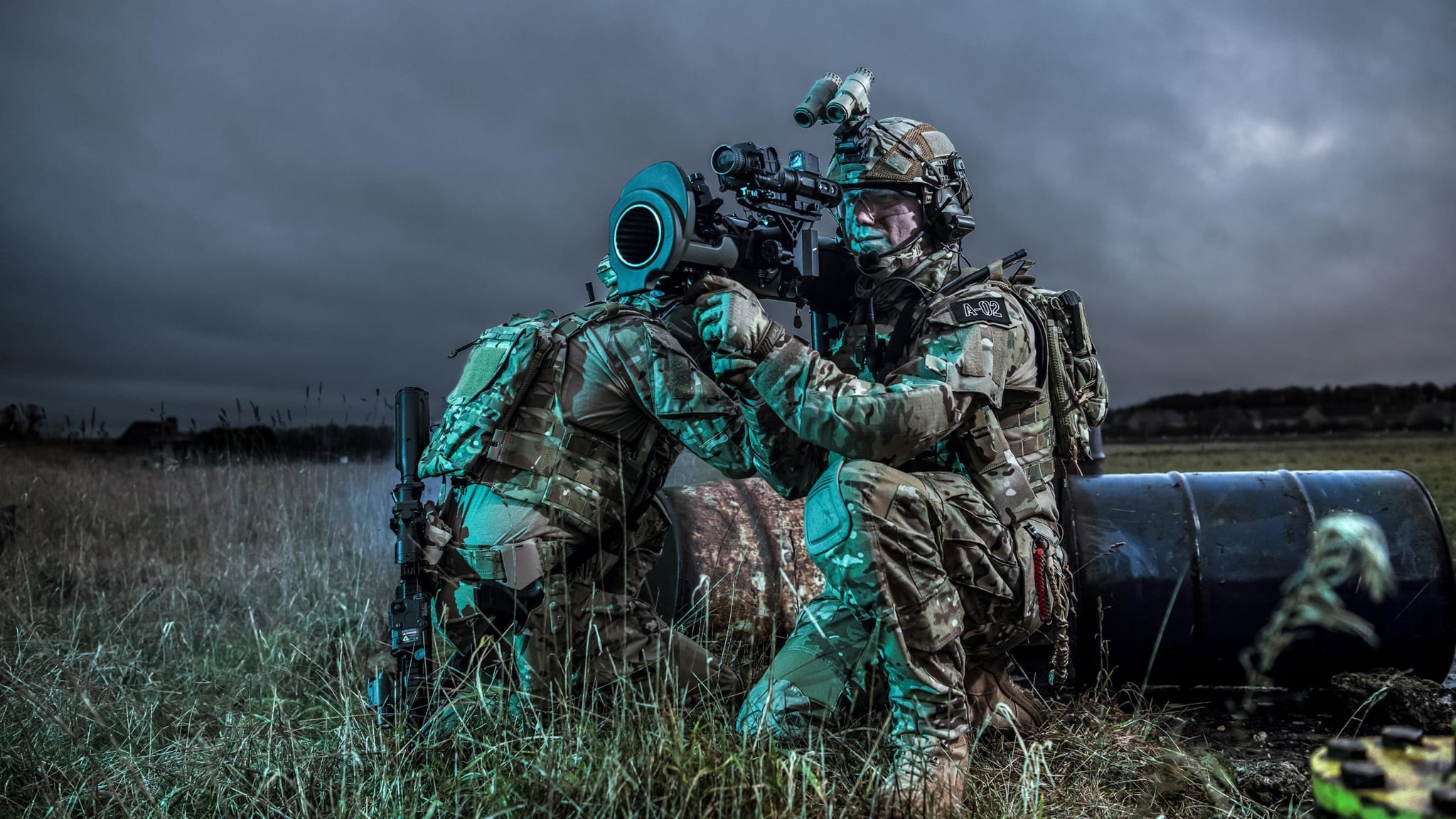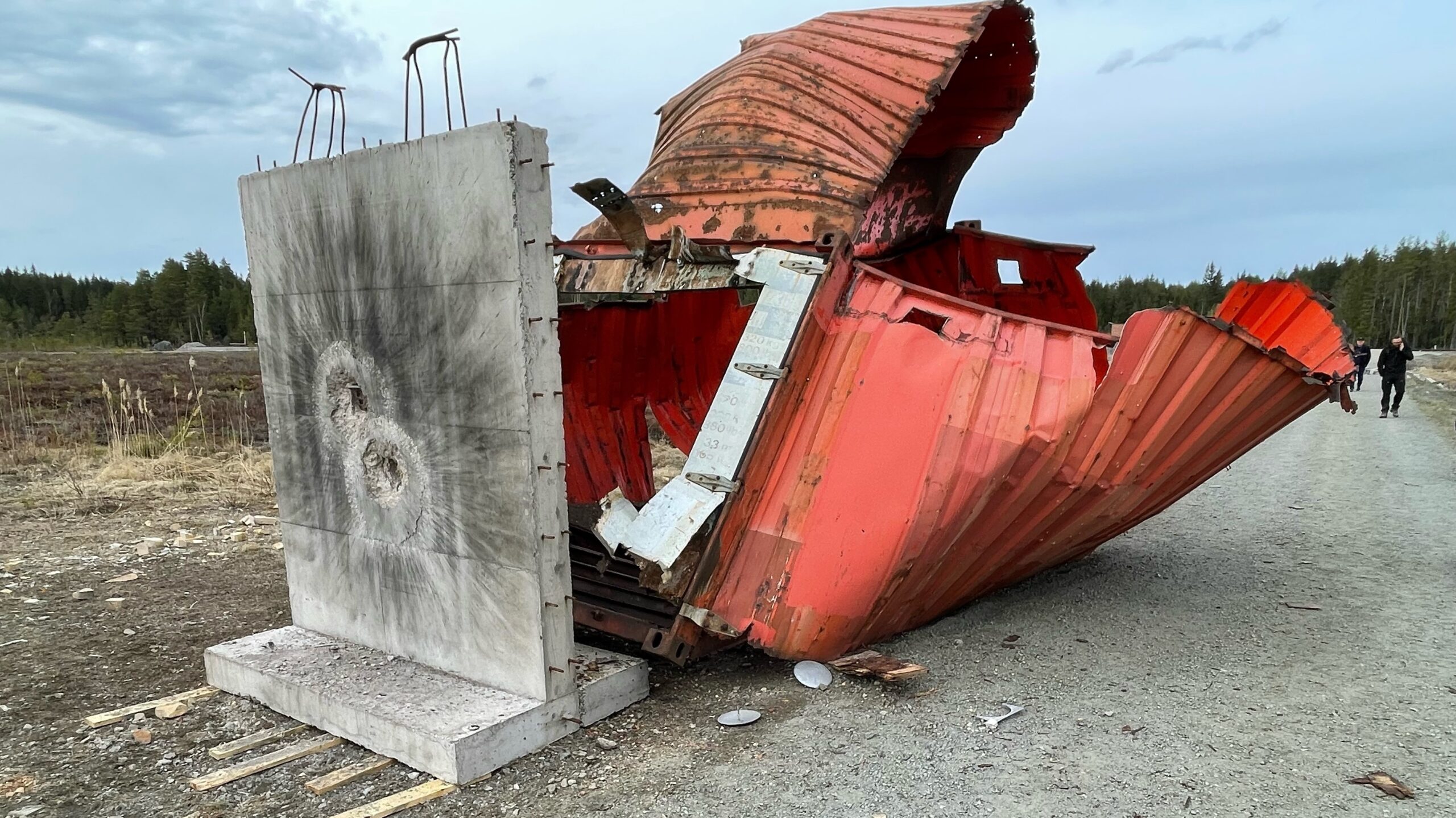REUBEN JOHNSON

KARLSKOGA, Sweden: With Sweden formally petitioning to join NATO after decades of balancing between the alliance and Russia, a new spotlight is being cast on its domestic defense industry, and particularly its defense giant Saab.
The company, ranked as the 36th largest defense firm in the world, seems likely to welcome the opportunity to get its equipment into the hands of more NATO nations. In particular, it has recently put renewed emphasis on anti-armor, anti-structure and anti-personnel weaponry, the kind of equipment which could be vital in the sort of urban combat now occurring in Ukraine.
On May 3-4, Saab and its armed forces partners completed a two-day series of live-fire demonstrations, including a series of night-time firings, the largest such demonstration at the company’s facilities since 2014. While the timing was coincidental — one Saab official said “this is an event that has been planned for several years now but was postponed more than once due to the many complications and restrictions caused by the COVID pandemic” — the potential utility of the weapons months after Russia’s invasion is clear.
In a presentation on the development of his own armed forces, the Commander of the Swedish Army, Maj. Gen. Karl Lorentz Engelbrekt Engelbrektson, told reporters that these kind of man-portable anti-armor systems were vital because “in the end, the real war is on the ground.”
The Swedish government has recently given the ground forces chief the charge to double the size of the force he has under arms. “For the first time in my career I do not see money as the biggest hurdle” to overcome, he said.
If that’s the case, Saab seems poised to cash in with a series of updated capabilities — if they are able to have production match demand. The demonstrations were conducted before a large audience of defense attaches, weapons specialists and procurement officials from 30 users worldwide of this Saab weaponry — plus prospective customers. Breaking Defense, like other outlets, accepted travel and accommodations to attend the event.
The centerpiece of Saab’s man-portable arsenal is the latest M4 variant of the Carl Gustaf (aka “Charlie G”, “Charlie Swede” and a host of other nicknames) 84mm recoilless rifle. The system was originally developed and is produced by Saab Bofors Dynamics at Karlskoga at Sweden’s state arsenal Carl Gustafs Stads Gevärsfaktori, originally founded by the 17th century Swedish King Charles X Gustav. This newest version of the popular weapon continues efforts by Saab towards making the system progressively lighter, with the M4 weighing 7.5 lbs less than the previous variant.
While Sweden has not directly supplied any units of this weapon to the Ukrainian military, 100 launchers and 2,000 rounds of ammunition were provided to Kyiv by the Government of Canada. Shortly after the live-fire exercises concluded it was reported that one of these Canada-supplied Carl Gustafs was used to destroy only the second Russian Army UralVagonZavod (UVZ) T-90M main battle tank (MBT) to be lost by Moscow in this war.
A video showing the May 4 hit on the T-90M has been viewed extensively on Twitter, YouTube and other platforms. The kill was credited to the Ukrainian 127th Brigade of the country’s Territorials Defence Force. On the Ukrainian MoD’s Twitter page, the video was posted with the caption “Near Stary Saltiv, Kharkiv Territorial Defense fighters eliminated another new T-90M ‘Breakthrough’ tank. The pride of the Russian tank industry was destroyed by the Swedish hand-held anti-tank grenade launcher Carl Gustaf. We thank the Swedish people and the King for their help.”
Despite not being the latest in Moscow’s armor, technology analysts familiar with the T-90M design point out that the effectiveness of the Carl Gustav against this target is no small accomplishment. The T-90M is constructed with the latest in layered steel alloy and composite armor with the majority of the chassis and the turret also equipped with reactive armor tiles. It is also protected by the active protection system Shtora-2 and with an IR countermeasures module.
Over the two days of demonstrations the lethality of the M4 against a wide range of targets was demonstrated — as was the versality of the many different categories of rounds that can be fired by the launcher. These included the anti-personnel capability of the system that includes rounds fitted with warheads that deploy flechettes, as well airburst rounds.
NLAW: Bjorn-Again
The two other major weapons demonstrated were two single-shot-and-discard designs: the several variants of the AT4, perhaps the most versatile weapon produced by Saab, and the Next Generation Light Anti-Armour Weapon (NLAW), with a significant UK supply chain and final assembly there.
The NLAW was described by one of the pre-demonstration firing briefers as a born-again phenomenon because of its success in the Ukraine war. More than 3,600 units were originally shipped to Ukraine by NLAW customers in the war’s initial phase and another 6,000 were promised in March, with most of these being supplied by the UK government.
Ukrainian field commanders have stated the NLAW has been far more effective in the conflict against armored vehicles than any of its Soviet-design analogues. The system has been called the “weapon of choice” by some Ukrainian officers and is credited with between 30-40 percent of the kills recorded against Russian MBTs.
One of the utilities of the Saab-designed weapons is that they exit the launcher tube and only after initially airborne does the rocket motor ignite. This “shoot and scoot” capability of the system makes it possible for the troops firing the weapon to not reveal their position — a weakness of several previous-generation ATGMs.
“But it is inaccurate to call these ‘fire and forget’ weapons,” quipped the briefer who profiled the weapons prior to the live-fire demo. “Due to them being ‘smart’ weapons these are more like ‘fire and remember’ systems. We are not in a rush to forget.”
AT4 and Sweden’s Modern Army
Sweden’s objectives for the force structure they have built echoes the experience of the Ukraine armed forces in their conflict against Russia. It is also — based on background conversations that multiple Swedish armed forces and industry officials had with Breaking Defense — a by-product of Sweden’s expressed interest in applying for NATO membership.
“A modern army,” Engelbrektson stated, “must be capable of creating A2/AD [anti-access/area denial] zones by employing a fusion of Air Force, Army and Navy sensors. A modern army is not at all a low-tech force, but on the contrary is very high-tech. It is also not massed in giant formations, but instead is dispersed across the battlefield.”
It is in this concept of deployment that the utility of the disposable AT4 system comes into play. “The new Swedish army is a combined arms formation,” he said. “One of the decisions of this concept is that everyone in the Swedish forces is going to be capable of firing an AT4. This dispersal of so many high-lethality weapons in force-on-force engagements and the use of effective camouflage is what wins.”
The current “lessons learned” in the Ukraine conflict bear out the plans for Sweden’s defense forces, but they also demonstrate the utility in the R&D performed by Saab in developing the many different warheads used in the AT4. The design of the shaped charges used in these warheads has been accomplished by using supercomputing methods that were in previous decades (due to the expense of supercomputer runs) the exclusive preserve of the development of nuclear warheads and other WMD munitions.

The results of Saab’s “keyhole round” during the live fire test. (Reuben Johnson/Staff)
This high-technology approach to warhead design has produced several new variants of the AT4, one of which is anti-structure version. Demonstrated at the Karlskoga firing range, this is a weapon that is designed to destroy the inside of a room in a building rather the building’s exterior.
Called a “keyhole round,” this version uses a single penetrating charge to create a small breech in the wall of a building. Then the secondary main charge enters the room of that building and detonates once inside. In theory, the weapon should mean enemy forces cannot shelter in place and expect their cover to protect them from incoming rounds.
Ammunition and Logistics
From a strategic standpoint, the conflict is forcing a re-think on what constitutes levels of munitions production adequate to support large-scale, protracted conflicts. If a scenario such as that in Ukraine are the future of land warfare then current production levels are “anemic,” to quote more than one analyst of the war.
At about the same time as the Ukrainians were scoring their second T-90M kill with the Carl Gustaf, former EUCOM commander Lt. Gen. Ben Hodges spoke in a lengthy podcast with a group of national security fellows from the Hoover Institution at Stanford University. Hodges is currently the Pershing Chair in Strategic Studies at the Center for European Policy Analysis (CEPA) in Frankfurt, Germany.
Despite the Russian military’s embarrassing performance to date, Hodges raised a concern for Ukraine and its partners: the rate at which materiel is being used up. “Ammunition consumption” in the Ukrainian conflict, he stated, “is through the ceiling.” The day is coming soon when the number of US weapons supplied to Ukraine, as well as the NLAWs and other Saab-designed systems that have seen action, will have to be curtailed due to a lack of available stocks.
That concern has now spread to members of the US Congress and top Pentagon officials, who have openly discussed whether Javelin and Stinger weapons can be produced at high-enough rates to meet need. It also was a topic for Saab President and CEO Micael Johansson, who in late April said the company is looking to double production of the NLAWS, AT4 and Carl-Gustaf systems. Johansson noted the firm is working on new production lines at its Swedish facilities in Karlskoga and Linköping and at its US plants in Orlando, Fla., and Lillington, N.C, “as quickly as possible” to ramp up “within a year.”
“There is no one in the world who sells more ground combat systems and the training that goes with it than we do,” said the director of the Dynamics business area of Saab during the trip. “But our order book is currently at a record high level.
“We do not fully know what will happen since the [Ukraine] war has kicked off on Feb. 24. Karlskoga is unique in that we are self-contained in the R&D and production of our systems and we can expand our own production” without excessive reliance on multiple second- and third-tier suppliers, the director said.
“But to for us do so, there is the need to hire more people and to engage in more R&D – a need that is growing. To our credit, implementation problems in the field have been minimized, in that in the introduction of new launchers like the M4 we have ensured backwards compatibility in that they can still fire all of the previous-generation rounds.”
But, increasing Saab’s production will require long-range commitments to larger orders from the Swedish MoD and other customers – thereby creating the necessary economies of scale, said another Saab official.
No comments:
Post a Comment